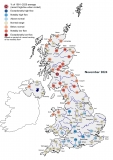Submitted by Eugene Magee on
November was an unsettled and mild month, and for the UK as a whole, it was the third warmest November in a series from 1884. Following the exceptionally dry summer, November concluded a wet autumn with UK total rainfall a fifth above average. Correspondingly, river flows were generally above normal to exceptionally high, with between twice and four times the average in some catchments. Soils were wetter than average in all regions and soil moisture deficits (SMDs) were eliminated in some. Groundwater levels responded to the November rainfall in many areas, with some steep increases in the more responsive aquifers. Reservoir stocks increased at almost all impoundments, some substantially so (e.g. Ardingly increased by 47% relative to average). Despite this, many remained well below average, including Colliford which set a new November minimum of 25% of capacity (in a series from 1988). The very wet autumn has been transformative, and the recharge season has commenced in many areas – although it does so from well below average. This, coupled with the dry start to December and a winter outlook favouring normal to below normal flows and groundwater levels (e.g. in much of the south and east of England), means that water resource concerns remain in some areas. Winter rainfall will be important for securing supplies for the spring and summer.



